Hassani S. Mathematical Physics: A Modern Introduction to Its Foundations
Подождите немного. Документ загружается.

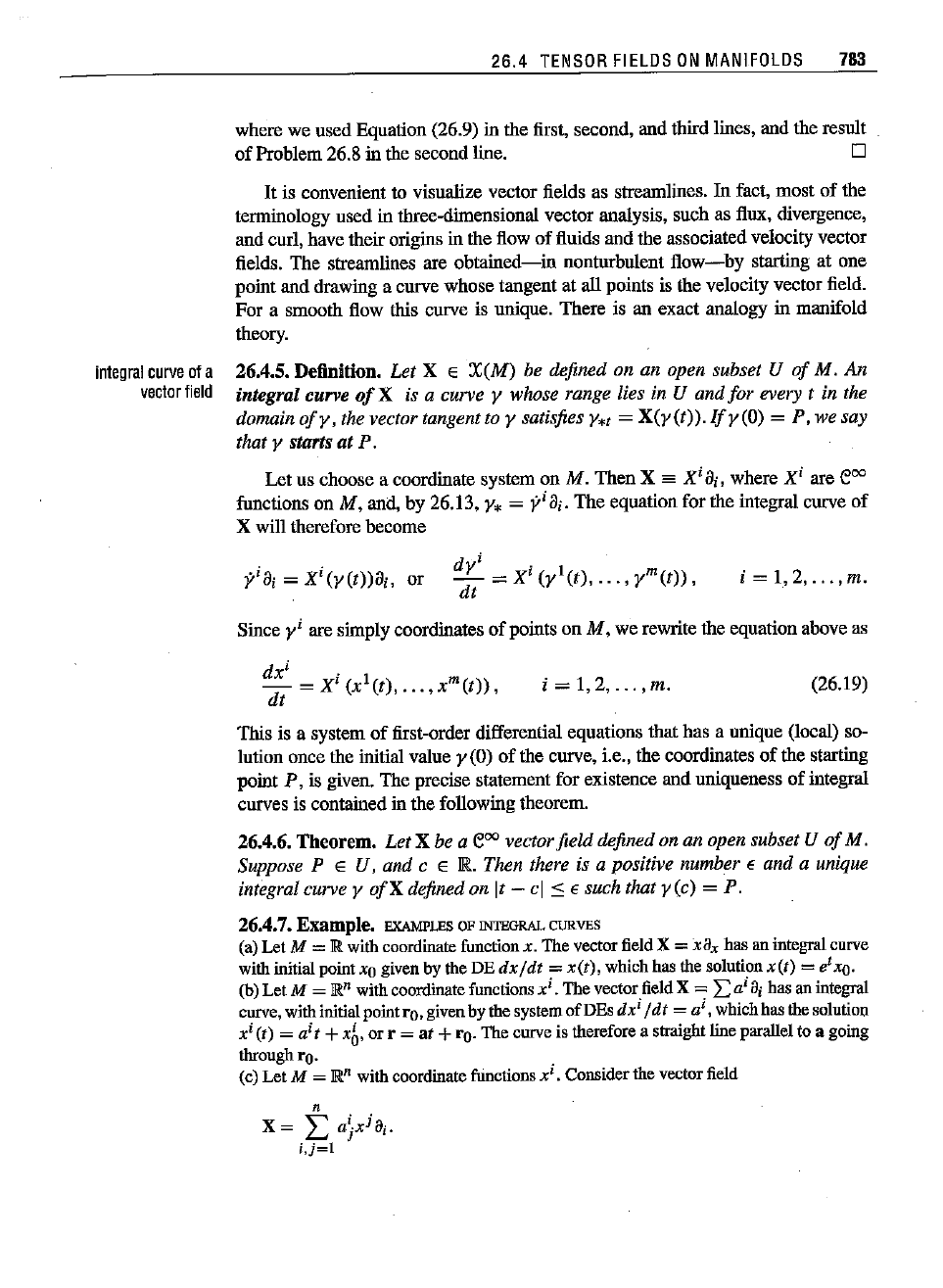
integral
curve
ofa
vector
field
26.4
TENSOR
FIELDS
ON
MANIFOLDS
783
where we used Equation (26.9) in the first, second, and third lines, and the result
of
Problem 26.8 in the second line. D
It is convenient to visualize vector fields as streamlines.
In fact, most of the
terminology used in three-diroensional vector analysis, such as flux, divergence,
and curi, have their origins in the flow of fluids and the associated velocity vector
fields. The streamlines are
obtained-in
nonturbulent
flow-by
starting at one
point and drawing a curve whose tangent at
all points is the velocity vector field.
For a smooth flow this curve is unique. There is an exact analogy in manifold
theory.
26.4.5. Definition.
Let X E
X(M)
be defined on an open subset U
of
M. An
integral curve
of
X is a curve y whose range lies in U and for every t in the
domain
ofy,
the vector tangent to y satisfies
Yot
=
X(y(t)).
Ify(O)
= P, we say
that y starts at P.
Let us choose a coordinate system on
M.
Then
X =
Xi
ili, where
Xi
are e
oo
functions on M, and, by 26.13, Y. =
yi
8i. The equation for the integral curve of
X will therefore become
yi8i
=X
i(y(t))8i,
or dJri =
Xi
(yl(t),
...
,
ym(t)),
i =
1,2,
..
.
,m.
Since
yi
are siroply coordinates of points on
M,
we rewrite the equation above as
dx
i
i 1 m
- = X (x
(t),
...
, x
(t)),
dt
i =
1,2,
...
, m.
(26.19)
This is a system
of
first-order differential equations that has a unique (local) so-
lution once the initial value
y(O) of the curve, i.e., the coordinates
of
the starting
point
P, is given. The precise statement for existence and uniqueness of iutegral
curves is contained in the following theorem.
26.4.6.
Theorem.
Let X be a e
oo
vectorfield defined on an open subset U
of
M.
Suppose P E U, and c E R Then there is a positive number E and a unique
integral curve y
of
Xdefined on It - c]
:s
E such that
y(c)
= P.
26.4.7.
Example.
EXAMPLES OF INTEGRAL CURVES
(a)LetM =R
with
coordinate
functionx. Thevectorfield X =
xa
x
hasan
integral
curve
withinitial point
XD
givenby theDE
dxt
dt =
x(t),
whichhasthesolution
x(t)
= etxD.
(b) Lei M =
JR"
withcoordinate functions xi . The vectorfieldX = La
i
Bi
hasanintegral
curve,
with
initial
point
rD.
givenbythesystemafDEs dx
i
/ dt = a
i
•whichhasthe
solution
xi (r) = a
i
t +xb. orr = at +tu- The
curve
is
therefore
a
straight
line
parallel
toa going
through rD.
(c) Let M = R" with
coordinate
functions
xi.
Consider the vectorfield
"
X =
L:
a}x
i
ai·
i,j=l

784 26. ANALYSIS
OF
TENSORS
The integral curve
of
this vector field, with initial
point
ro- is given by the system
of
DEs
dx
i
fdt
=
LJ=l
a}x
i
,
which can be written in vector
fonn
as dr
tdt
= Ar where A is a
constant matrix.
By differentiating this equation several times, one can convince oneself
that
dkr
fdt
k
= Akr.TheTaylorexpansionofret) thenyields
(d)
Let
M =
]R2
with coordinate x, y. The reader
may
verify that the vector field X =
-ya
x
+Xay has anintegralcurvethrongh(xo,
YO)
givenby
x=xocost-Ya
sint,
y=xosint+YOcost,
i.e., a circle centered at the originpassing through (xQ. Yo). III
Going back to the velocity vectorfield analogy, we can think of integralcurves
as the path of particles flowing with the fluid.
If
we think of the entire fluid as a
manifold
M,
the flow of particles can be thought of as a transformation of M. To
be precise, let
M be an arbitrary manifold, and X E
:reM).
At each point P of
M,
there is a unique local integral curve r»
of
X starting at P defined on an open
subset
U
of
M. The map F
,
: U
--+
M defined by
F,(P)
=
yp(t)
is a (local)
transformation of
M. The collection
of
such maps with different
t's
is called the
flow
ofa
vector
field
flow of the vector field X. The uniqueness
of
the integral curve
yp
implies that F
,
is a local diffeomorphism. In fact, the collection of maps
(F
,
Item:
forms a (local)
one-parameter
group
one-parameter
group
of
transformations
in the sense that
of
transformations
F
t
0 F, = F
t
+
s
,
Fo
= id,
(26.20)
Global1-parameler
group
of
transformations;
complete
vector
fields
One has to keep in mind that F
,
at a point P E M is, in general, defined only
locally in t, i.e., only for t in some open interval that depends on P. For some
special, but important, cases this interval can be taken to be the entire R for all
P,
in which case we speak of a global
one-parameter
group
of
transformations,
and X is called a complete
vector
field on
M.
The symbol F
,
used for the flow of the vector field X does not contain its
conuection to X.
Iu
order to make this conuection, it is cornmon to defiue
F
,
sa exp(tX).
(26.21)
This definition, with no significance attachedto "exp" at this point, converts Equa-
tion (26.20) into
exp(tX)
0 exp(sX) = exp[(t +
s)Xj,
exp(OX) = id,
[exp(tX)]-1
=
exp(-tX),
(26.22)
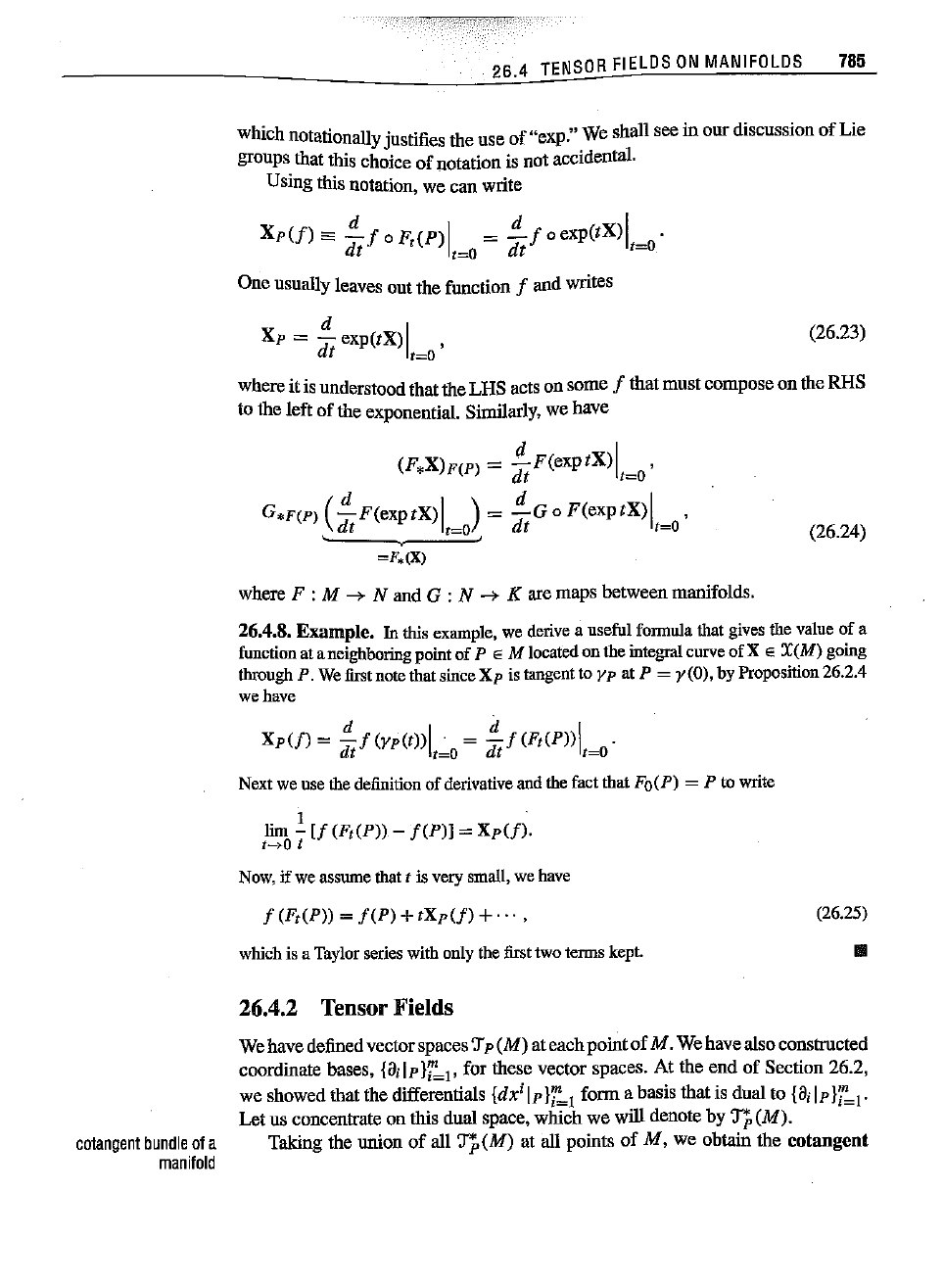
(26.23)
26.4
TENSOR
FIELDS
ON
MANIFOLDS
785
which notationallyjustifies the
use
of
"exp,"
We shall see in
oor
discussion
of
Lie
groups that this choice
of
notation is not accidental.
Usingthis
notation,
we can
write
Xp(f)
'"
~f
0 F:
(P)J
=
~
f 0 exp(tX)I .
dt '
,=0
dt
,=0
One usually leaves out the function f and writes
x, =
~
exp(tX)I '
dt
'=0
whereit is understoodthatthe
LHS
acts on some f that
must
composeon the RHS
to the left
of
the exponential. Similarly, we have
(F.X)F(P)
=
~F(exPtX)1
'
dt
'=0
G.F(P)
(~F(exPtX)J
) =
~G
0
F(exptx)1
'
dt
,=0
dt
,~O
\ I
(26.24)
=F.(X)
where F : M
-->
N and G : N
-->
K are maps hetween manifolds.
26.4.8.
Example.
In this example, we derivea useful formulathat givesthe valueof a
functionataneighboring pointof
P E M locatedonthe integralcorveof X E X(M) going
throughP. Wefirst notethatsinceXp is taugeutto yp at P = y(O), by Proposition26.2.4
we have
Nextwe usethe
definition
of
derivative
and
thefact
that
Fo{P)
= P to
write
. I
hm -
[f
(F,(P))
-
f(P)]
=
Xp(f).
t-+O t
Now,if we
assume
that
t is very
small,
we
have
f
(F,(P))
=
f(P)
+
tXp(f)
+... ,
which
is a
Taylor
series
withonlythe
first
two
terms
kept.
26.4.2
Tensor
Fields
(26.25)
III
We have definedvectorspaces'J'p
(M)
at each
point
of
M.
We have also constructed
coordinate bases,
{adp
Ii'=!,
for these vector spaces. At the
end
of
Section 26.2,
we showed that the differentials
{dx
i
Ip
Ii'=!
form
a hasis that is dual to
{ad
p
Ii':,,!.
Let
us concentrate on this dual space, which we will denote hy
'JP
(M).
colangent
bundle
ofa Takiug the union
of
all 'JP(M) at all points
of
M,
we obtain the
cotangent
manifold
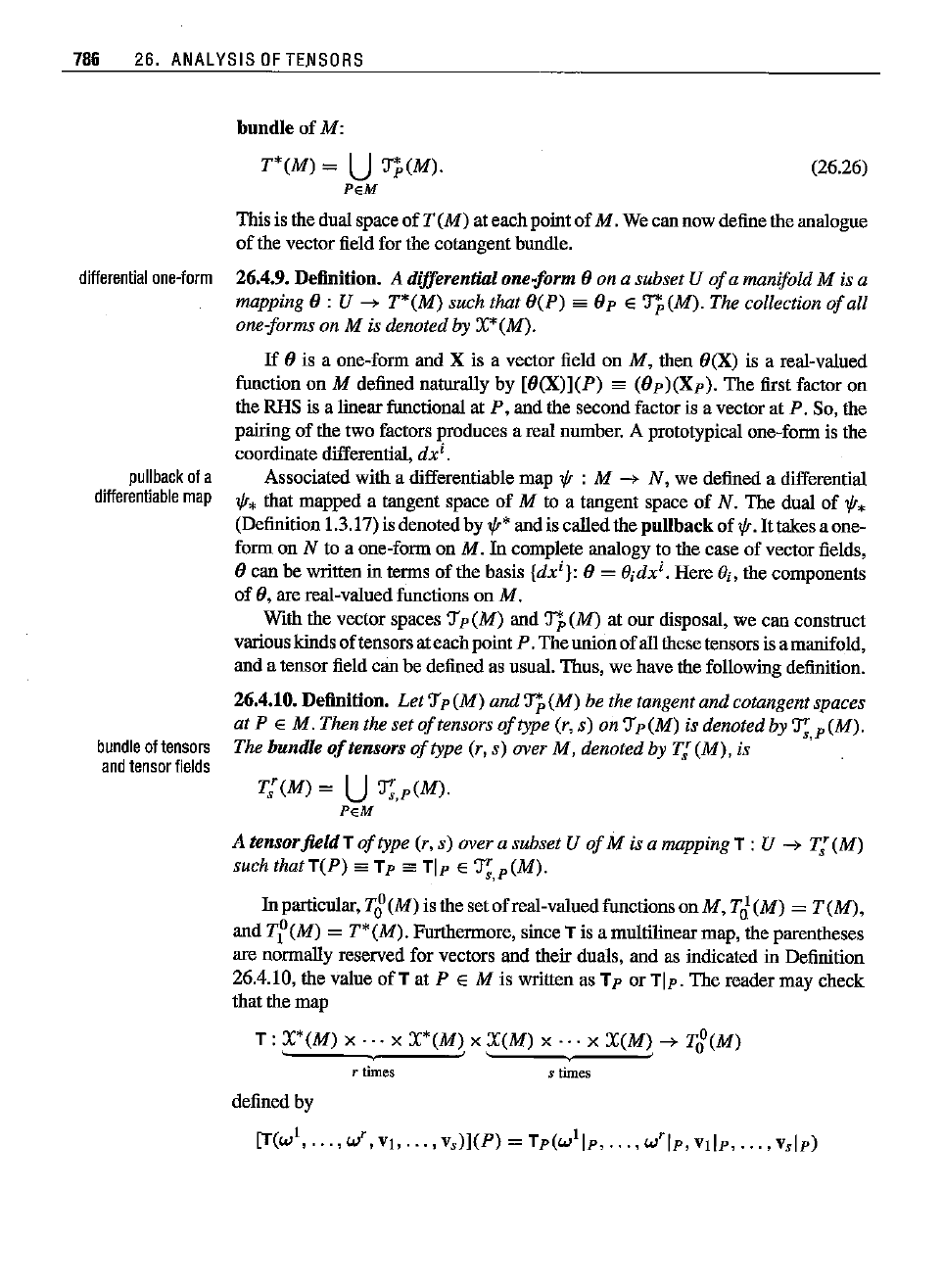
786
26.
ANALYSIS
OFTENSORS
bundle
of
M:
(26.26)
differential
one-term
pullback
ofa
differentiable
map
bundle
01
tensors
andtensor
lieids
T*(M)
= U
'Jj,(M).
PEM
This is the dual space
of
T
(M)
at eachpoint
of
M.
We can now define the analogue
of
the vector field for the cotangent bundle.
26.4.9. Definition.
A differential one-form 0 on a subset U
of
a manifold M is a
mapping 0 : U
~
T*(M)
such that O(P) sa Op E
'Jj,(M).
The collection
of
all
one-forms on M
is denoted by
X*(M).
If
0 is a one-form and X is a vector field on
M,
then
O(X) is a real-valued
function on
M defined naturally by [O(X)](P) sa
(Op)(X
p).
The
first factor on
the RHS is a linear functional at
P, and the second factor is a vector at P. So, the
pairing
of
the two factors produces a real number. A prototypical one-form is the
coordinate differential,
dx
i
.
Associated with a differentiable map
lfr
: M
~
N,
we defined a differential
lfr*
that mapped a tangent space
of
M to a tangent space
of
N. The dual
of
lfr*
(Definition 1.3.17)is denotedby
lfr*
and is calledthe
pullback
of
lfr.
It
takes a one-
form on
N to a one-form on M. In complete analogy to the case
of
vector fields,
ocan be written in terms
of
the basis {dx
i
}:
0 = Oidxi. Here Oi,the components
of
0, are real-valued functions on
M.
With the vector spaces 'J'p
(M)
and 'Jj,
(M)
at our disposal, we can construct
various kinds
of
tensors ateachpoint P.
The
union
of
all these tensors is amanifold,
and a tensor field can be defined as usual. Thus, we have the following definition.
26.4.10. Definition.
Let
'J'p
(M)
and
'Jj,(M)
be the tangent and cotangentspaces
at P
E M. Then the set
of
tensors
of
type (r, s) on 'J'p(M) is denoted by
T;,p(M).
The bundle
of
tensors
of
type (r, s) aver M, denoted by
T;(M),
is
T;(M)
= U
'r.,p(M).
PEM
A tensorfield T
of
type (r, s) over a subset U
of
M is a mapping T : U
~
T;
(M)
such
thatT(P)
sa Tp sa Tip E
T;,p(M).
10particular,
Tg(M)
is the set
of
real-valuedfunctions
onM,
TJ(M)
=
T(M),
and
T?(M)
=
T*(M).
Furthermore, since T is a multilinear map, the parentheses
are normally reserved for vectors and their duals, and as indicated in Definition
26.4.10, the value
ofT
at P E M is written as Tp or
Tip.
The
reader may check
that the map
T:
X*(M)
x
.:.
x X*(M), x
X(M)
x
...
x X(M),
~
Tg(M)
r times
s times
defined by
[T(w!,
...
,
w',
VI,
...
,
v,)](P)
=
Tp(w!lp,
...
,
w'lp,
vdp,
...
,v,lp)
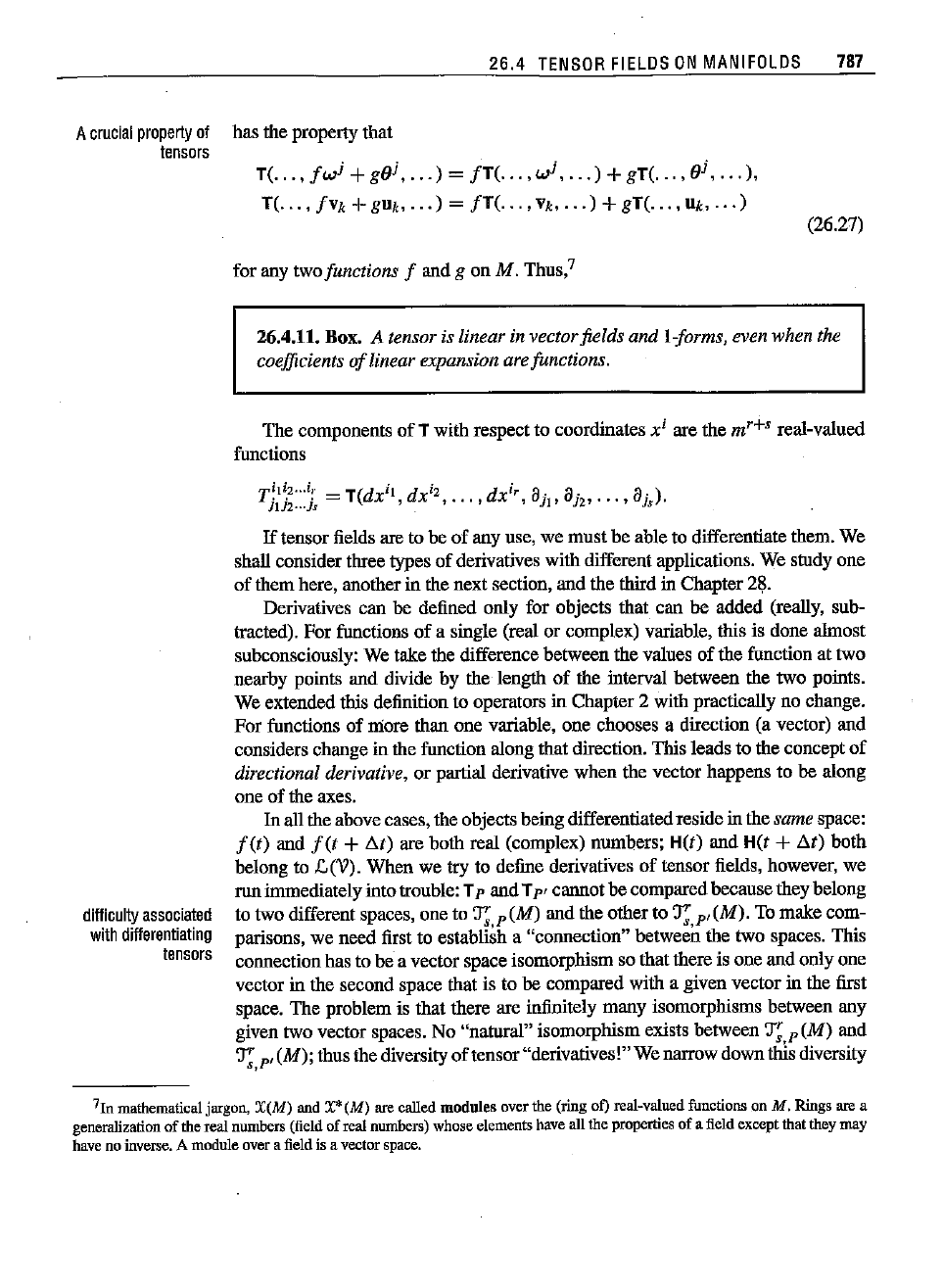
26.4
TENSOR
FIELDS
ON
MANIFOLDS
787
A
crucial
properly
of has the property that
tensors
T( ,
fw
i
+gOi, ) =
fT(
,wi,
) +gT( , o',
),
T( ,
fVk
+gUk, ) =
fT(
, Vb ) +
gT(
,Uk, )
(26.27)
for any two functions f and g on M. Thus,7
26.4.11. Box.
A tensor is linear in vectorfields and i-forms, even when the
coefficients
of
linear expansion arefunctions.
The
components
of
T with respect to coordinates xi are the m
r
+, real-valued
functions
difficulty
associated
with
differentiating
tensors
If
tensor fields are to be
of
any use, we
must
be
able to differentiate them. We
shall consider three types
of
derivatives with different applications. We stody one
of
them here, another in the next section,
and
the third in Chapter
2~.
Derivatives can be defined only for objects that can be added (really, sub-
tracted). For functions
of
a single (real or complex) variable, this is done almost
subconsciously: We take the difference between the values
of
the function at two
nearby points
and
divide by the length
of
the interval between the two points.
We extended this definition to operators in Chapter 2 with practically no change.
For functions
of
more than one variable,
one
chooses a direction (a vector) and
considers change in the function along that direction. This leads to the concept
of
directional derivative, or partial derivative
when
the vector happens to be along
one
of
the axes.
In
all the above cases, the objects beingdifferentiatedreside in the same space:
f(t)
and
f(t
+
!'>t)
are
both
real (complex) numbers; H(t)
and
H(t +
At)
both
belong to 'c(V).
When
we try to define derivatives
of
tensor fields, however, we
run immediatelyintotrouble: T
p
and
T
p'
cannotbe comparedbecausethey belong
to two different spaces, one to
'Y,.P
(M)
and the
other
to
'Y"p,
(M).
To make com-
parisons, we need first to establish a "connection" between the two spaces. This
connectionhas to be a vector space isomorphism so thatthere is one
and
onlyone
vector in the second space that is to be compared with a given vector in the first
space.
The
problem is that there are infinitely
many
isomorphisms between any
given two vector spaces. No "natura!" isomorphism exists between
'J'r
p
(M)
and
s,
'J"
p'
(M);
thus the diversity
of
tensor"derivatives!"We narrowdownthis diversity
s,
7In mathematical jargon,
X(M)
and X*
(M)
are called
modules
over the (ring of) real-valued functions on
M.
Rings are a
generalization
of
the real numbers (field of real numbers) whose elements have all the properties of a field except that they may
have no inverse. A module over a field is a vector space.
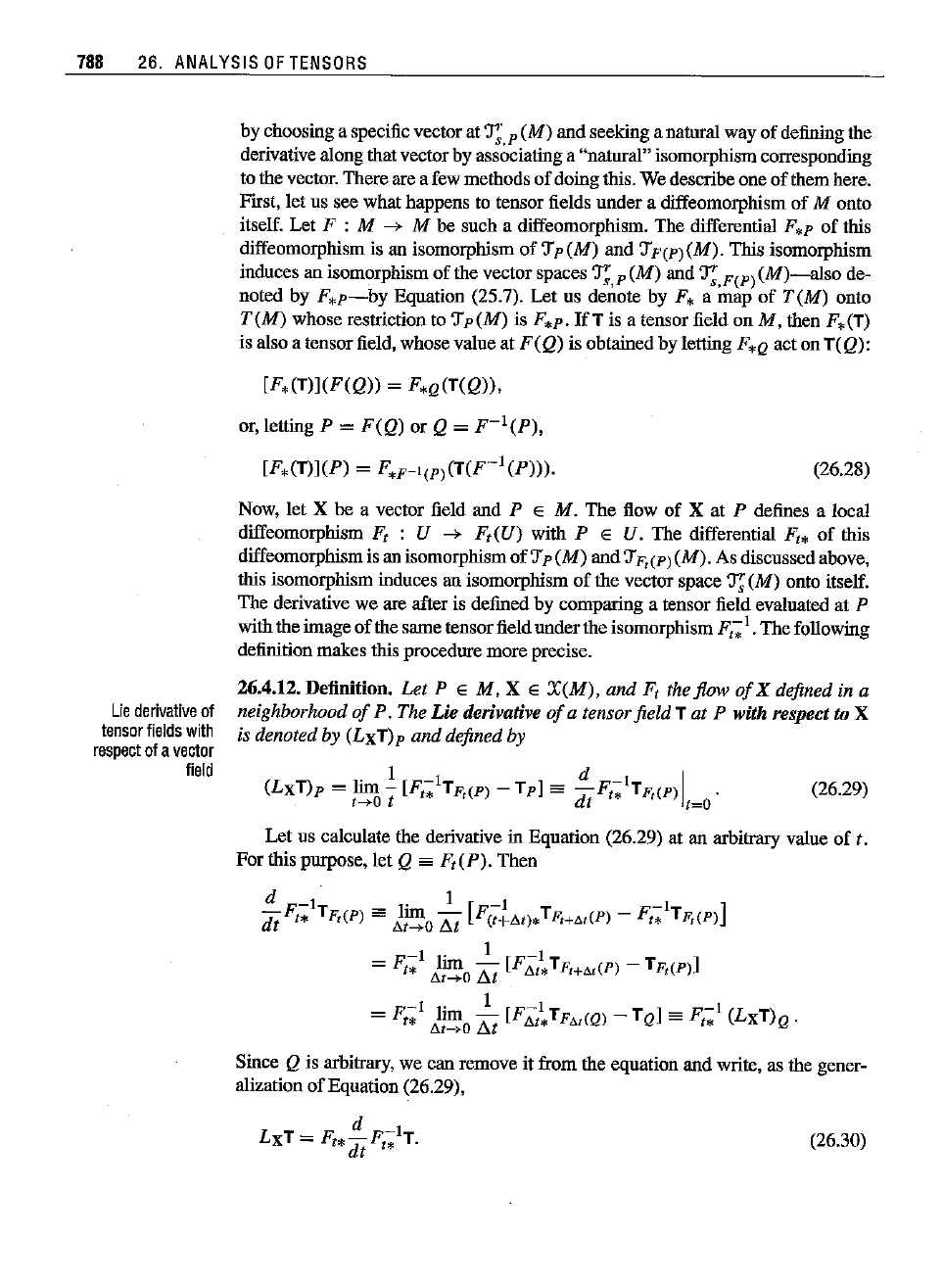
788
26.
ANALYSIS
OF
TENSORS
by choosing a specific vectorat
T,'.
p
(M)
and seeking a natnral way of defining the
derivative along
tihat
vectorby associating a "natural" isomorphism corresponding
to
tihe
vector. There are afew methods of doingtihis. We describe one of tihemhere.
First, let us see what happens to tensor fields under a diffeomorphism of
M onto
itself. Let
F : M --+ M be such a diffeomorphism. The differential
F.p
of this
diffeomorphism is an isomorphism
of'J"p(M) and 'J"p(p)(M). This isomorphism
induces an isomorphism of
tihe
vector spaces
T;,p
(M)
and T;,p(p)
(M)-also
de-
noted by
F.p-by
Equation (25.7). Let us denote by F. a map
of
T(M)
onto
T(M)
whose restriction to 'J"p(M) is
F.p.
1fT
is a tensor field on M,
tihen
F.(T)
is also a tensor field, whose value at
F(Q)
is obtained by letting F.Q act on T(Q):
[F.(T)](F(Q))
= F.Q(T(Q)),
or, letting P =
F(Q)
or Q =
F-
1(P),
[F.(T)](P) = F.
P_l(P)(T(F-
1(P))).
(26.28)
(26.30)
Lie
derivative
of
tensor
fields
with
respect
ofa
vector
field
Now, let X he a vector field and P E
M.
The flow of X at P defines a local
diffeomorphism
F, : U --+
F,(U)
witih P E U. The differential F,. of
tihis
diffeomorphism is an isomorphismof'J"p
(M)
and
'J"
P,(P)
(M).
As discussedabove,
this isomorphism induces an isomorphism
of
tihevector space T;
(M)
onto itself.
The derivative we are after is defined by comparing a tensor field evaluated at
P
witih
tihe
imageof
tihe
sarne tensorfield undertiheisomorphism
F,-;
1
.
The following
definition makes this procednre more precise.
26.4.12. Definition.
Let
P E M, X E
X(M),
and
F, the flow
of
X defined in a
neighborhood
of
P. The
Lie
derivative
of
a tensor field Tat P with respectto X
is denoted by
(Lx
T)p
and
defined by
(26.29)
Let
us calculate
tihe
derivative in Equation (26.29) at an arbitrary value of t.
For
tihis
purpose, let Q sa
F,(P).
Then
d I
dt
F,-;tTp,(P)
==
l~o
/';t
[F(-;-~tH).
TpHO'(P)
- F,-;l
Tp,(p)]
I
=
F,-;t lim A
[Fi,~
Tp,+o,(P)
- Tp,(p)]
dt"""*O
ilt
1
=
F,-;!
lim -
[Fi,~TFo,(Q)
-TQ]
==
F,-;l (LxT)Q .
.6..t~O
8t
Since Q is arbitrary, we can remove it from
tihe
equation and write, as
tihe
gener-
alization of Equation (26.29),
d
-t
LxT
= F,.-F,. T.
dt
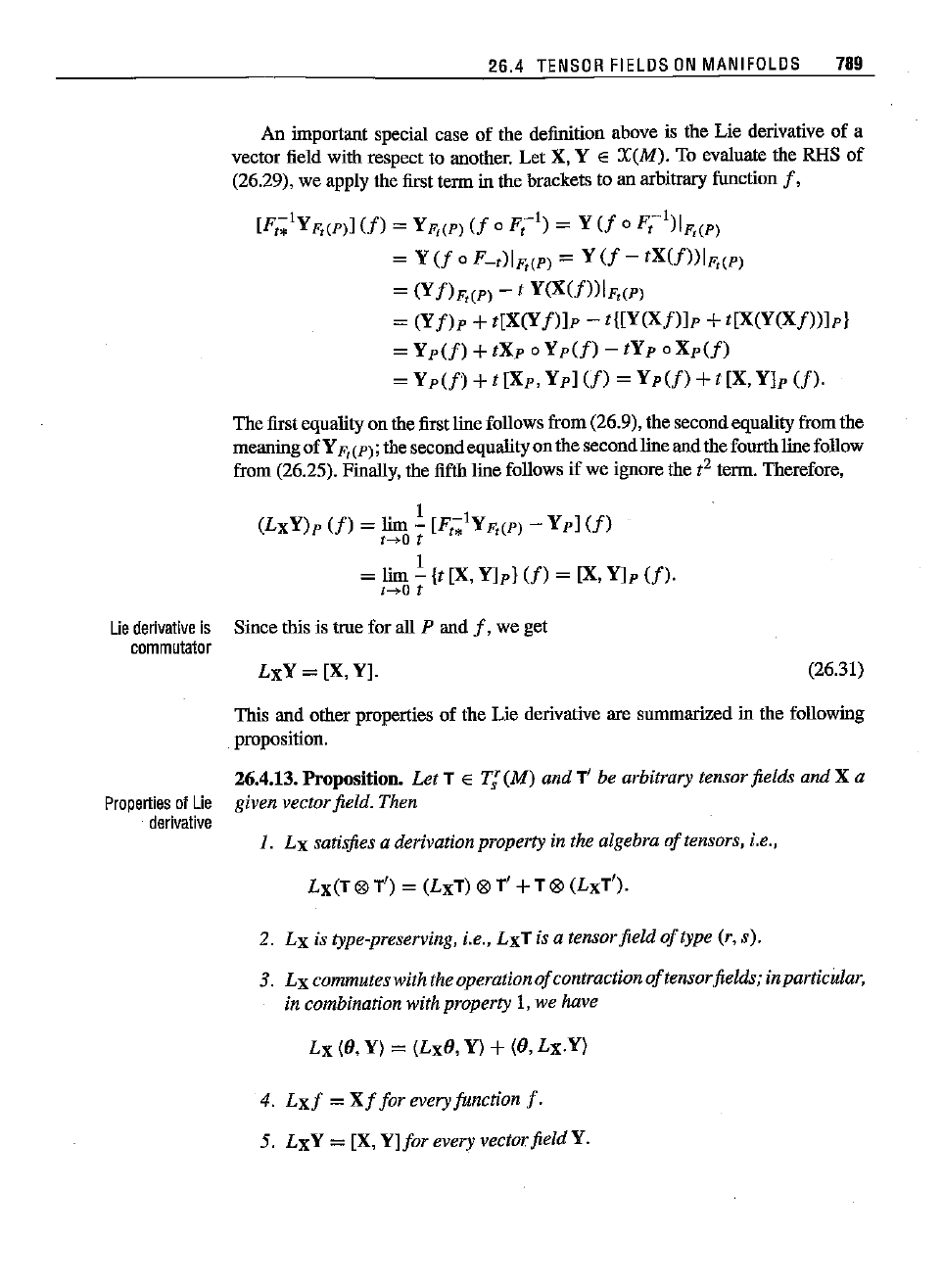
26.4
TENSOR
FIELDS
ON
MANIFOLDS
789
An important special case
of
the definition above is the Lie derivative
of
a
vector field with respect to another. Let X, Y
E
:reM).
To evaluate the RHS
of
(26.29), we apply the first term in the brackets to an arbitrary function
f,
[F,-;;l
YF,(P)](f) =Y
F,(P)
(f
0 F;-l) = Y
(f
0 F,-l)IF,(p)
=Y
(f
0
L,)IF,(P)
=Y
(f
- tX(f))IF,(P)
=
(Y
f)
F,(P)
- t
Y(X(f))IF,(P)
=
(Yf)p
+
t[X(Yf)]p
-
t{[Y(Xf)]p
+
t[X(Y(Xf))]p}
=
Yp(f)
+
tXp
0
Yp(f)
-
tYp
0
Xp(f)
=
Yp(f)
+t [Xp,
Yp](f)
=
Yp(f)+t
[X,
Y]p
(f).
The
first equalityon the first line follows from (26.9), the secondequalityfrom the
meaning
ofY
F,(P);
the secondequality
au
the secondlineand the fourth line follow
from (26.25). Finally, the fifth line follows
if
we ignore the t
2
term. Therefore,
(LxY)p
(f)
=
lim!
[F,-;;l
y
F,(p)
-
Yp]
(f)
t--*O t
. 1
= lim - It[X,
Y]p}
(f)
= [X,
Y]p
(f).
t--+O
t
Lie
derivative
is Siuce this is true for all P and
f,
we get
commutator
LxY=
[X,
Y].
(26.31)
This and other properties
of
the Lie derivative are summarized in the following
proposition.
26.4.13.
Proposition.
Let T E T;
(M)
and T' be arbitrary tensor fields and X a
Properties
of
Lie
given vectorfield. Then
derivative
1.
Lx
satisfies a derivation property in the algebra
of
tensors, i.e.,
LX(T@
T)
= (LxT) @T' +T@
(LxT').
2.
Lx
is type-preserving, i.e.,
LxT
is a tensorfield
of
type (r, s).
3.
Lx
commutes with theoperation
of
contraction
of
tensorfields; inparticular,
in combination with property 1, we have
Lx
(9,Y) =
(Lx9,
Y) +(9,
Lx.Y)
4.
Lxf
=
Xf
for everyfunction
f·
5.
LxY
=
[X,
Y]for
every vector
fieldY.
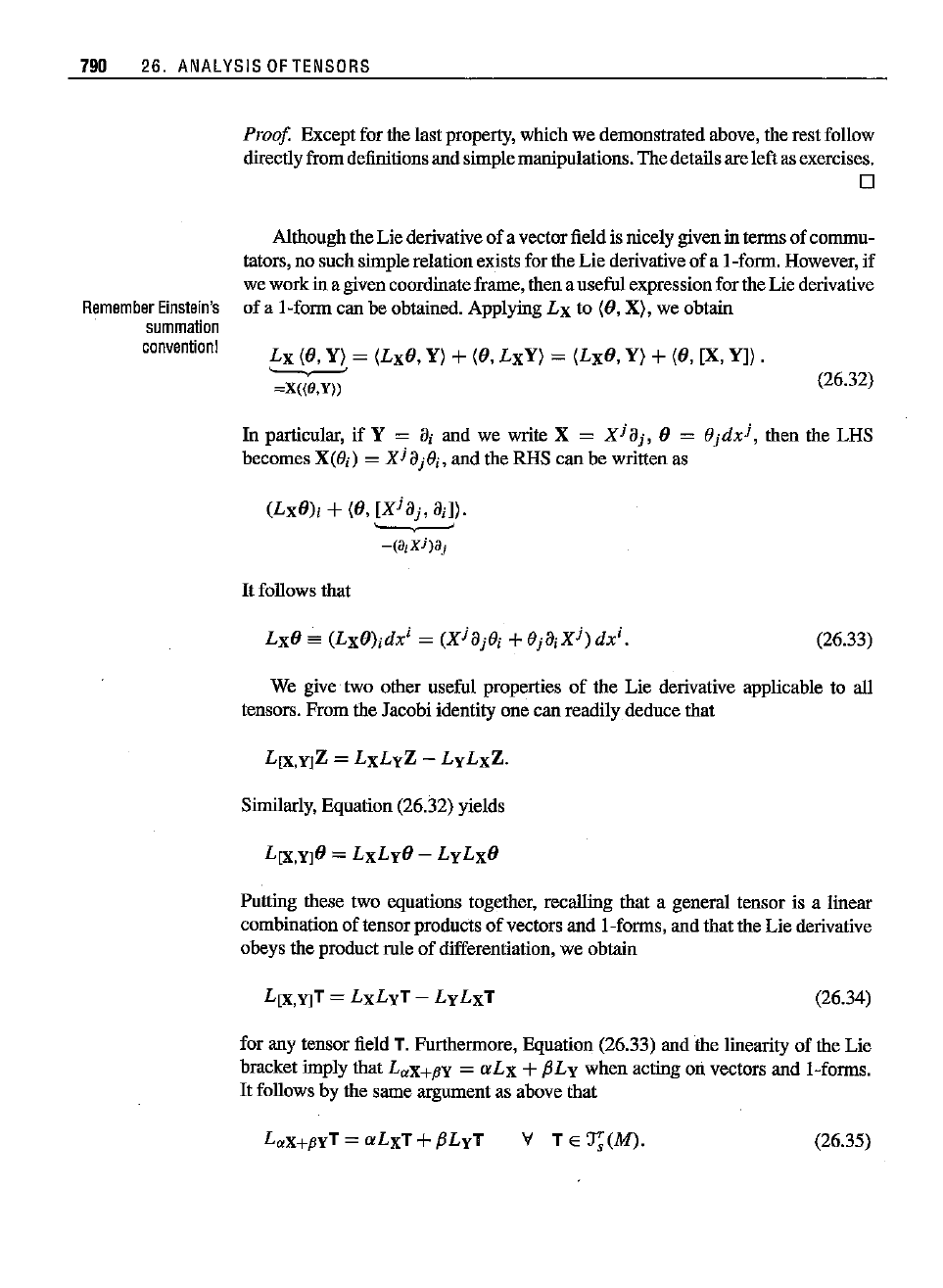
790
26. ANALYSIS
OF
TENSORS
Proof Exceptfor the last property, which we demonstrated above, the rest follow
directlyfrom definitions and simplemanipulations. The detailsare left asexercises.
o
Although the Lie derivative of a vectorfield is nicely given in terms of commu-
tators, no such simple relation exists for the Lie derivative
of
a I-form. However, if
weworkinagiven
coordinate
frame,
then
ausefulexpression fortheLie
derivative
of a I-form can be obtained. Applying
Lx
to (II,X), we obtain
Remember
Einstein's
summation
convention!
Lx
(II,Y) =(LxII, Y) +(II,
LxY)
=(LxII, Y) +(II, [X,
V])
.
'----,.-'
=X«O,y})
(26.32)
In particular, if Y
=
a,
and we write X =
xjaj,
II = Ojdx
j,
then the LHS
becomes
X(O;) = XjajO" and the RHS
can
be written as
(LxII), +(II,
[X
j
aj,
ail).
~
-(ajxi)aj
It
follows that
(26.33)
We
give two other useful properties
of
the Lie derivative applicable to all
tensors. From the Jacobi identity one
can
readily deduce that
L[x,YlZ =
LxLyZ
-
LyLxZ.
Similarly, Equation (26.32) yields
L[X,y]1I
=
LxLyll-
Ly
LxII
Putting these two equations together, recalling that a general tensor is a linear
combinationof tensor products
of
vectors and I-forms, and that the Lie derivative
obeys the product rule of differentiation, we obtain
L[X,y]T=
LXLyT
-
LyLxT
(26.34)
for any tensor field T. Furthermore, Equation (26.33) and the linearity of the Lie
bracket imply that
L.x+py
=
aLx
+fJLy when acting on vectors and I-forms.
It
follows by the same argument as above that
L.X+pyT =
aLxT
+fJLyT v
TE'1;(M).
(26.35)
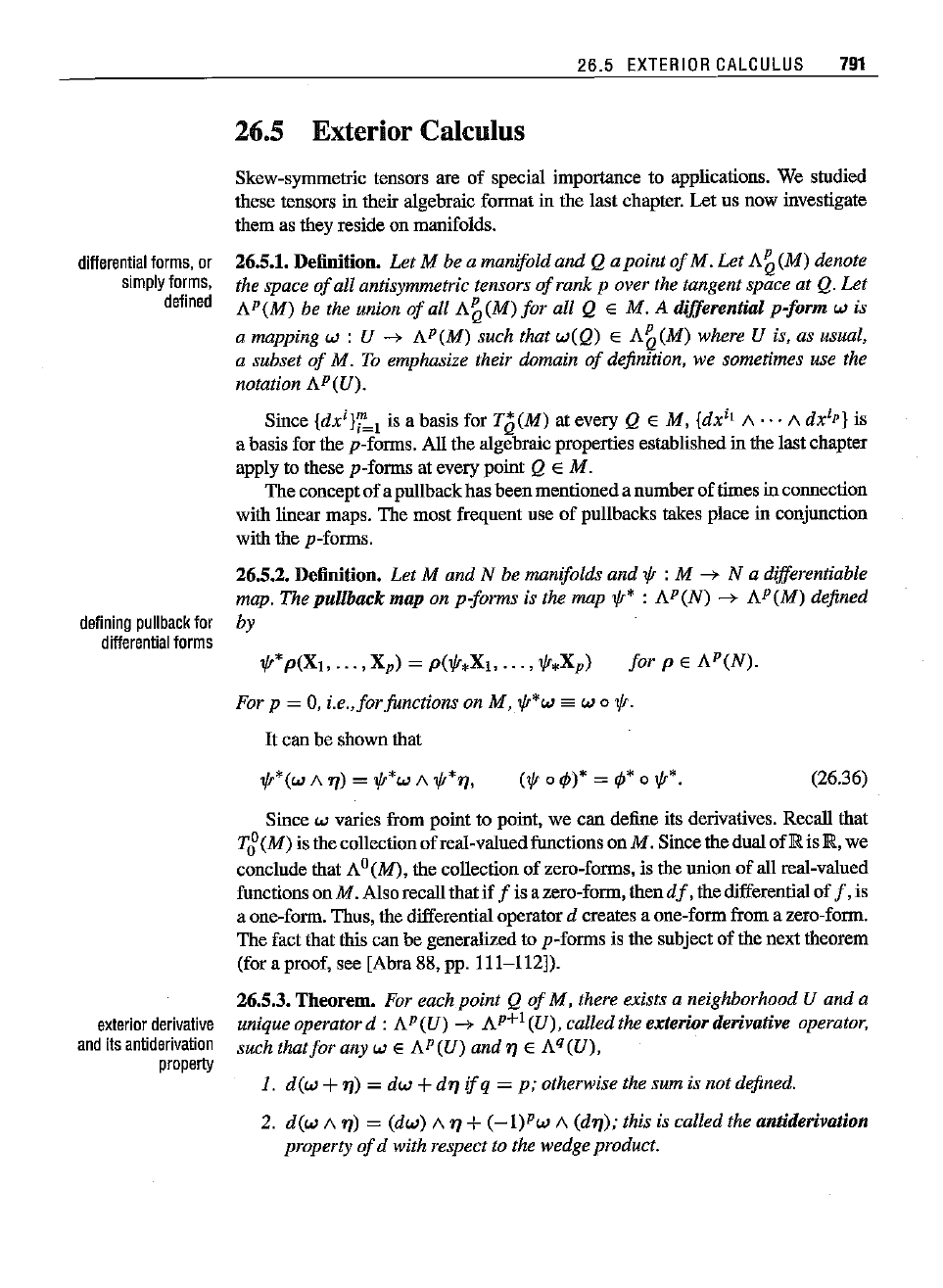
differential
forms.
or
simply
forms,
defined
26.5
EXTERIOR
CALCULUS
791
26.5 Exterior Calculus
Skew-symmetric tensors are of special importance to applications. We studied
these tensors in their algebraic format in the last chapter. Let us now investigate
them as they reside on manifolds.
26.5.1. Definition.
Let M be a manifold
and
Q a point
of
M. Let
A~(M)
denote
the space
of
all antisymmetric tensors
of
rank p over the tangent space at Q. Let
AP(M)
be the union
of
all
A~(M)
for all Q E M. A dijJerential
p-form
w is
a mapping w : U
->
AP(M)
such that
w(Q)
E
A~(M)
where U is, as usual,
a subset
of
M. To emphasize their domain
of
definition, we sometimes use the
notation
AP(U).
Since
{dxi}7'~l
is a basis for TQ(M) at every Q E M, {dx
i1
A
...
A
dx
ip}
is
a basis for the p-forms. All the algebraic properties establishedin the lastchapter
apply to these p-forms at every point
Q E
M.
The conceptof apullbackhas beenmentioneda numberof times in connection
with linear maps. The most frequent use
of
pullbacks lakes place in conjunction
with the p-forms.
26.5.2. Definition.
Let M and N be manifolds
and
1/r
:M
->
N a differentiable
map. The pullback map on p-forms is the map
1/r*
:
AP(N)
->
AP(M)
defined
defining
pullback
for by
differential
forms
for P E
AP(N).
For p = 0, i.e.ifor functions on M,
1/r*w
sa w 0
1/r.
It
can be shown that
(1/r
0
</J)*
=
</J*
0
1/r*.
(26.36)
exterior
derivative
and
its
antiderivation
property
Since w varies from point to point, we
can
define its derivatives. Recall that
Tg(M)
is the collectionof real-valuedfunctions on M. Since the dual of R is
JR,
we
conclude that A
o(M), the collection of zero-forms, is the union
of
all real-valued
functions on
M. Also recall that if f is azero-form, then
df
,the differential of
f,
is
a one-form. Thus, the differential operator
d creates a one-form from a zero-form.
The fact that this can be generalized to
p-forms is the subject of the next theorem
(for a proof, see [Abra 88, pp.
111-112]).
26.5.3.
Theorem.
For each point Q
of
M, there exists a neighborhood U and a
unique operator d : AP(U)
->
AP+! (U), called the exteriorderivative operator,
such thatfor any
WE
AP(U)
and
rz
E
Aq(U),
1. dew +
rz)
=
dw
+
dn
if
q =
p;
otherwise the sum is not defined.
2. dew
A
rz)
= (dw) A
rz
+
(-I)Pw
A (drz); this is called the antiderivation
property
of
d with respect to the wedge product.

792 26.
ANALYSIS
OF
TENSORS
3.
d(dwl
=
afar
any differentialform w; stated differently,
dod
=
O.
4.
df
=
(a;jldx
i
for
any real-valuedfunction
f.
5. d is natural with respect to pullback; that is,
du
0
1ft*
=
1ft*
0 dN
for
any
differentiable map
1ft
: M
...,.
N. Here
du
(dNi is the exterior derivative
operating on differential forms
of
M (Ni.
26.5.4. Example. Let M =
IR
3
andw =
ajdx
i
a l-form on M. The
exterior
derivative
ofwis
dW=(dai)Adxi
=
(ajaidxj)Adx
i
=
~)ajai
-aiaj)dxj
Adx
i.
j-ci
(26.37)
The
homogeneous
Maxwell's
equations
are
written
in
terms
of
differential
forms.
Wesee
that
the
components
of
dw
arethe
components
of V x A
where
A =
Cal,
oz.
a3).
Itfollows
that
thecurlof a
vector
in
JR.3
is the
exterior
derivative
ofthel-form
constructed
outof thecomponents of the
vector.
1m
26.5.5. Example. In
relativistic
electromagnetic
theory
the
electric
and
magnetic
fields
are
combined
toformthe
electromagnetic
field
tensor.
Thisisa
skew-symmetric
tensor
field
of
rank
2, whichcanbe
written
as
8
F=
-Exdt
Adx - Eydt Ady - Ezdt Adz
+ Bzdx
A dy - Bydx A dz + Bxdy
Adz,
where
t is thetime
coordinate
andthe
units
aresuch
that
c, thevelocity
of
light, isequalto
1.
Let
us
take
theexterior derivative ofF. In theprocess, we use
df
=
(a;f)dx
i
,d(dx
i
A
dx
j)
= 0,
and
indE; or
dBj
we
include
onlythetenus
that
givea
nonzero
contribution:
dF = -
(aE
x
dy + aE
x
dz)
A dt A dx _
(aE
y
dx
+ aE
y
dz)
Adt
Ady
~
h b h
_
(aE
Z
dx
+ aE
z
dy)
Adt Adz +
(aB
Z
dt + aBz
dz)
Adx Ady
ax ay at az
_
(aB
y
dt
+ aBy
dy)
Adx Adz +
(aB
x
dt + aB
x
dX) Ady
Adz.
at ay at ax
Collecting all
similar
terms
and
taking
into
account
changes
ofsignduetothe
antisymmetry
of the
exterior
products
gives
(
aE
y
aEx aBZ)
(aE
Z
ee;
aBy)
dF =
--
-
--
+- dt Adx Ady + - -
--
- - dt Adx Adz
b
~
h b h at
(
aE
Z
aEy aB
X )
(aB
x aBy aBZ)
+ - - - + - dt Ady 1\ dz + - + - + - dx Ady
Adz
~
h h b
~
az
=
[(v
x
E+
~~)Jdt
rc
dx
Ady
+
[(v
x
E+
~~)Jdt
Adz
rc
dx
+
[(v
x
E+
~~)Jdt
Ady
Adz+
(V·
B)dx /v dy
Adz
SNotehow in thewedge
product,
the
first
factor
hasalowerindex(is an
"earlier"
coordinate)
than
thesecond
factor.
If this
restriction
is tobe
removed,
weneedto
introduce
a
factor
of!
foreach
component
(seeExample26.5.11).
